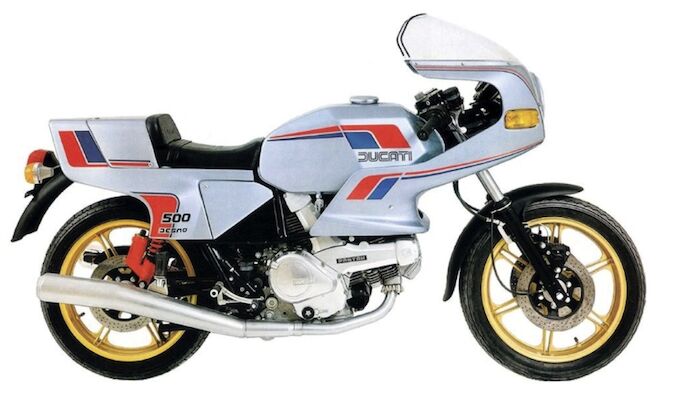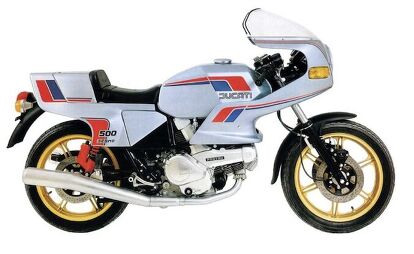The Falloon Files: Ducati Pantah
Dr. T strikes again
Well it’s not always about me. Or is it? One of the first things I remember seeing after I’d finally busted out to California, up there on the beautiful Presidio of Monterey, was my first Ducati. It was January 1981, and a pale baby blue, so it must’ve been one of the very first 500 SL Pantahs. Exotic place (for the Army, anyway), exotic bike. So exciting.
Ian Falloon, as always, has the whole story, excerpted here from his excellent The Complete Book of Ducati Motorcycles.
The 1970s was another decade distinguished by poor management and dubious marketing moves. The year 1974 saw the end of the singles and round-case 750s, replaced by the ungainly 860 and an unremarkable parallel twin. In 1976, when Ducati’s management finally realised that the parallel twins were a commercial disaster, legend has it that Ing. Fabio Taglioni smiled, reached into his bottom drawer, and presented full technical drawings for a 500cc V twin engine.
Camshaft drive by toothed rubber belts rather than the traditional bevel gears ensured this new engine would be both cheaper to manufacture than the bevel-drive engines and quieter running as well. This design was also Taglioni’s most enduring, having begun its production life in 1979. Over that time it has grown from 498cc to 1078cc, and spawned an entire range of sophisticated four-valve Ducatis. No other Ducati engine has had so much influence on the direction of the company. So superior was the Pantah engine in terms of reliability and cost effectiveness that within six years it was the only engine produced by the company.
The Pantah engine single-handedly changed the perception of Ducatis and their reliability. Once considered idiosyncratic and only for enthusiasts prepared to spend time maintaining their machinery, the Pantah brought the Ducati legend to a far wider audience: Taglioni had saved the day yet again.
The Pantah could have gone into production almost immediately, but at the time Taglioni first showed it, the EFIM management was in turmoil. Between 1977 and 1978, motorcycle production at Borgo Panigale nearly halved, dropping from 7,167 to 4,436, partly due to a decline in the US market, but also because of Ducati’s unsatisfactory model range.
In July 1978, control of Ducati passed to another group, Finmeccanica, within the VM Group. This proved a dubious move for Ducati, as Finmeccanica was heavily involved in the production of diesel engines and was reluctant to increase motorcycle production. By 1979, however, Fabio Taglioni was finally allowed to put his new engine and motorcycle into production.
While the range of bevel-gear twins remained strongly influenced by the singles throughout their life span, the Pantah combined the past with the present. Its roots were in the 1971-73 500cc Grand Prix V-twin racers, the 90-degree twin-cylinder layout retaining the racer’s vertically split crankcases, but with the Pantah’s swingarm now pivoting on bearings within the gearbox casing. The idea was to bring the swingarm pivot as close as possible to the countershaft sprocket, thus reducing chain snatch. In many ways the Pantah was a mirror image of the larger twins with the helical primary drive gears on the right side, and the alternator on the left.
In the interests of improving reliability, a forged one-piece crankshaft with two-piece connecting rods and plain bearing big ends replaced the problematic pressed-together roller bearing crank of the bevel-drive engines. This was a significant update, and big-end problems became a thing of the past.
The two-valve cylinder heads featured a more up to date 60-degree included valve angle, and all versions had desmodromic valve actuation. Feeding these cylinder heads was a pair of large (for a 500) 36mm Dell’Orto PHF carburetors. A huge air cleaner and restrictive mufflers strangled the engine, so early 500s had to be revved hard to unleash the available performance. But unlike the bevel-drive engines, the Pantah didn’t self-destruct if over revved.
A trellis-type frame consisted of two pairs of parallel tubes running from the rear cylinder to the steering head, meeting another pair of tubes running up from the rear of the crankcases. The engine hung below the trellis and was bolted at six points. While the frame wasn’t exceptionally rigid it still provided the Pantah with sure-footed handling. It wasn’t the most compact frame, however, as the wheelbase was still a rangy 1450mm – but this was considerably shorter than the larger displacement twins.
Suspension was by Marzocchi front and rear, with a skinny 35mm diameter fork and the usual limp shocks. The triple disc brakes were also smaller than those fitted to the larger twins, with 260mm discs and small 05 series Brembo brake calipers at both ends.
When the first production Pantah appeared in 1980, the styling didn’t meet with universal acclaim. Those first 500SL’s were unlike other V-twin Ducatis in that they had very little bottom-end and mid-range power. They also lacked the rowdy mechanical note of the bevel twins; their toothed-belt camshaft drive, rubber plugs between the cylinder fins, and restrictive Conti silencers all conspiring to make the Pantah uncharacteristically quiet for a Ducati.
Racers Vanes Francini, Paolo Menchini, and Guido Del Piano successfully campaigned 600cc race-kitted Pantahs in the Italian National Junior Championship, ensuring that the 500 SL would grow into a 600. This happened for 1981, via a simple 80mm overbore creating the 600 SL. Power increased to 61 HP at 9100 rpm. While the chassis remained much as before, a silver and red color scheme set it apart from the pale blue 500. Beginning in 1982, the 600 SL was also available in the red/white/green Mike Hailwood Replica colors.
During this period Tony Rutter was virtually invincible on the factory TT2, winning four consecutive World Championships between 1981 and 1984. When the Endurance World Championship rules increased displacement to 750cc for 1984, Ducati felt they could be competitive with a Pantah-based 750 racer. Thus the 650 SL was born, purely to homologate the 61.5mm stroke for the 750 TT1. The 650 finally grew to 750 with the 1985 750 F1. In the meantime a range of dubious offspring grew out of the Pantah; the 350 XL, 350 SL, and the particularly ugly 350 and 600 TL. The SL Pantah may not have been the world’s most beautiful design, but the TL’s designers obviously penned it after Friday lunch break.
The Pantah lived on as the 350 and 650 Cagiva Alazzurra through 1987, and even today all the small capacity two-valve Ducati engines are based strongly on that first 500. Its central design features still influence much of the current engine line-up. Taglioni may be no longer be with us but his legacy continues.
Shop for The Complete Book of Ducati Motorcycles here
We are committed to finding, researching, and recommending the best products. We earn commissions from purchases you make using the retail links in our product reviews. Learn more about how this works.
Become a Motorcycle.com insider. Get the latest motorcycle news first by subscribing to our newsletter here.
More by John Burns










































Comments
Join the conversation
What's a Falloon?
Saw this close relative (Mille S2) at a local shop: https://uploads.disquscdn.c...